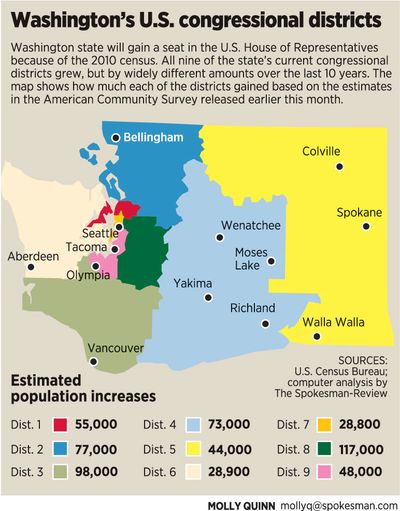Washington gains House seat
Growth in state outpaces national average, census data show

Washington will have a new congressional district when voters go to the polls in 2012, upping its population in the U.S. House of Representatives from nine to 10, U.S. Census Bureau officials announced Tuesday. Idaho, which had the fourth-highest percentage growth of any state, will stay at two House seats.
That’s what census officials said as they announced the official population of the United States, which stands at 308,745,538. That’s a jump of 9.7 percent for the nation as a whole.
Growth in the West is even higher, at 13.8 percent. Washington grew 14 percent, to 6,724,540.
Idaho grew by 21.1 percent. Its population came in at 1,567,582, but that wasn’t enough for a new congressional seat. The size of the average House seat is 710,767 people, although Idaho’s will be slightly larger and Washington’s slightly smaller.
Growth trends follow about a half-century of population shifting to the West and South, and away from the Northeast and the Midwest.
Although the states’ congressional districts won’t be redrawn until next year, more seats are being added in states that lean Republican, and more are being lost in states that normally lean Democratic.
Politicians all over Washington, from Gov. Chris Gregoire, a Democrat, to Luke Esser, state Republican Party chairman, welcomed the news that the state’s congressional delegation would grow.
“At a critical time in our nation’s history, not only do I welcome the additional representation in our nation’s Capitol, I am pleased Washington state’s share of federal funding to support critical programs like Medicaid and education will also increase,” Gregoire said.
Esser had a slightly different take: “An additional congressional seat gives our state the opportunity to send another voice to Congress to advocate for limited and fiscally conservative federal government.”
The Census Bureau didn’t release population breakdowns below the state level, but a separate survey released earlier this month suggests Washington’s population is growing fastest in the suburban areas east of the Puget Sound along the Interstate 5 corridor, and in central Washington.
Where Washington’s new district will go, and how the nine existing districts will change, will be up to the Redistricting Commission, which isn’t fully formed yet. The five-member commission has one member appointed by each of the four leaders of the Legislature. Those four appointees pick a fifth, nonvoting member to head up the commission.
The appointments to the board aren’t due until next month, although the two Democratic leaders recently submitted theirs. Senate Majority Leader Lisa Brown, of Spokane, appointed Tim Ceis, a former deputy mayor of Seattle and ex-chief of staff to former King County Executive Ron Simms. House Speaker Frank Chopp appointed Dean Foster, former clerk of the House and a member of the 2001 Redistricting Commission.
The Census Bureau will release population figures for the current congressional districts, counties and census blocks sometime in February or March. But the bureau released a five-year estimate from the American Community Survey earlier this month, which does have data for the districts.
The numbers don’t match perfectly: The 2009 ACS state estimate was 6,664,195, about 60,000 people fewer than the 2010 census. But by plugging the ACS estimates into computer mapping software and comparing it with district populations in 2001, The Spokesman-Review was able to analyze where the biggest growth likely will show up in the census breakdowns.
That analysis indicates the slowest growth in two solidly Democratic districts: the 7th, in urban Seattle, and the 6th, which has part of Tacoma and most of Olympic Peninsula. The highest growth was in the 8th District of suburban King and Pierce counties, which has always been Republican, followed by southwest Washington’s 3rd District, which switched from Democrat to Republican in November’s election, and northwest Washington’s 2nd District, where a Democratic incumbent barely held his seat. Central Washington’s 4th District, solidly Republican, was the fourth-fastest growing.
Spokane and Eastern Washington’s 5th Congressional District, another GOP stronghold, had the third-slowest growth in the ACS estimates, adding about 44,000 people.
All the districts will lose some people. But the commission has to worry about more than just raw population figures; federal law requires districts to try holding together cities, counties and “communities of interest” whenever possible.
The commission also will be redrawing the legislative boundaries. There’s no increase in the number of legislative districts, but the population shifts could lead to big changes there, too.
The commission will hold hearings around the state, draw up maps and submit them to the Legislature, which can only make minor changes.